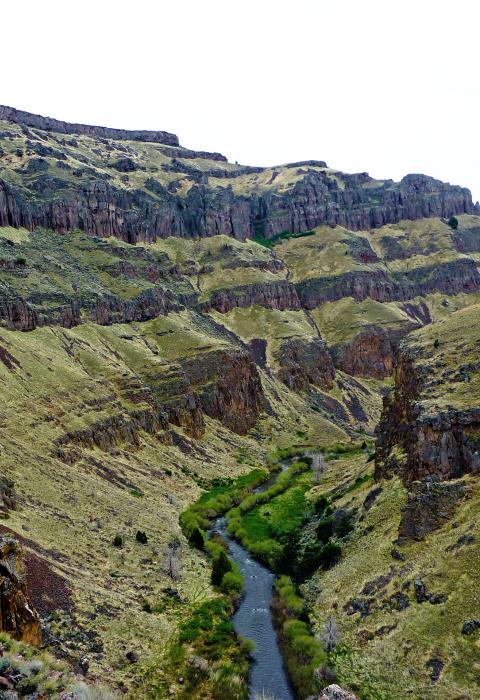West Fork Bruneau River
Idaho
The West Fork of the Bruneau River joins with the Jarbidge River to form the Bruneau River about 24 miles north of the Nevada border, just upstream of Indian Hot Springs. The canyon opens up at this portion of the river through the designated 0.3 miles and then becomes narrower as the Bruneau River flows north. The Jarbidge River becomes the Bruneau River where it is joined by the West Fork Bruneau.
Designated Reach
March 30, 2009. The West Fork of the Bruneau River from its confluence with the Jarbidge River to the downstream boundary of the Bruneau Canyon Grazing Allotment in the Southeast/Northeast quadrants of Section 5, Township 13 South, Range 7 East, Boise Meridian.
Outstandingly Remarkable Values
Botany
The Bruneau River phlox, a white-flowered and matted plant that clings to ledges, rock crevices, and cliffs, occurs in vertical or overhanging rhyolitic canyon walls, and the entire known extent of Bruneau River phlox in Idaho occurs within approximately 35 miles on the Bruneau, West Fork of the Bruneau, and Jarbidge Rivers.
Culture
Native Americans have utilized the canyonlands for shelter, weaponry, fish, game, and water for thousands of years. Petroglyphs, pictographs, rock alignments, shrines, and vision quest sites of the Shoshone and Paiute peoples are located throughout the Owyhee Canyonlands, and tribal members still frequent the canyonland areas to hunt, fish, pray, and conduct ceremonies.
Tradition in the area claims that Bruneau was either named by its French translation of ‘brown water’ or after a French explorer by the name of Jean-Baptiste Bruneau.
Fish
The Bruneau River, and the Jarbidge River upstream, support both redband trout and threatened bull trout, the latter being the only fish in the Owyhee Canyonlands that is federally listed under the Endangered Species Act. Jarbidge River bull trout are important because they occupy a unique and unusual semi-arid desert ecological setting, and their loss would result in a substantial modification of the species’ range.
Geology
The Bruneau, Jarbidge, and Owyhee river systems provide the largest concentration of sheer-walled rhyolite/basalt canyons in the western United States. Though not unique to southwest Idaho, the presence of these geologic formations in such great abundance and aerial extent makes the designated river segments geologically unique from a national perspective.
The geology of the canyons has been shaped by a combination of volcanic activity, glacial melt, and regional drainage patterns. The Bruneau-Jarbidge and Owyhee areas were the sites of the massive Owyhee-Humboldt and Bruneau-Jarbidge eruptive centers, whose explosions, massive rhyolite flows, and related glacial flows carved out the canyons that expose this activity. Where overlying basalt is present, the rhyolite formations are nestled in the rubble slopes below vertical walls of basalt. Weathering and erosion have carved immense monolithic cliffs and numerous sculptured pinnacles known as “hoodoos.”
There is one small-scale jasper mining claim in the vicinity of Indian Hot Springs in the Bruneau River Canyon, just downstream of the West Branch flows into the Bruneau.
Recreation
The Bruneau and Jarbidge Rivers have a national reputation among paddlers for their outstandingly remarkable float boating and associated experiences along the designated river sections, notably multi-day river trip options that feature remote, challenging whitewater (Class III, IV and V). The West Fork should only be run with kayaks and only by expert kayakers; it is extremely challenging due to its small size, numerous Class IV and V rapids, and potential for strenuous portages.
Scenery
The West Fork Bruneau Canyon is dominated by a mixture of high, vertical lines, and forms of coarse-textured, red, brown, or blackish eroded cliffs, often glazed with yellow to light green micro-flora. Steep diagonal lines associated with talus slopes feature yellow and subdued green sagebrush-bunchgrass, dark green juniper, reddish rhyolite and coarse, and blackish basalt rubble fields.
Wildlife
The Owyhee Canyonlands provide riparian habitats for a number of wildlife species common to southwest Idaho. Big game species commonly found in the area include California bighorn sheep, elk, mule deer, and pronghorn.
Common large and mid-sized predators in the area include cougars, bobcats, coyotes, badgers, and raccoons. Small mammals include rodents (mice, kangaroo rats, voles, squirrels, and chipmunks), rabbits, shrews, bats, weasels, and skunks. River otters are supported by year-long flows and a good prey base (fisheries). Birds include songbirds, waterfowl, shorebirds, and raptors.
This area includes Preliminary Priority Habitat for greater sage-grouse. Idaho BLM sensitive species include bald eagles, yellow-billed cuckoos, prairie falcons, ferruginous hawks, several neotropical migratory bird species, several bat species, Columbia spotted frogs, and western toads. Cliffs support spotted and Townsend’s big-eared bats.

